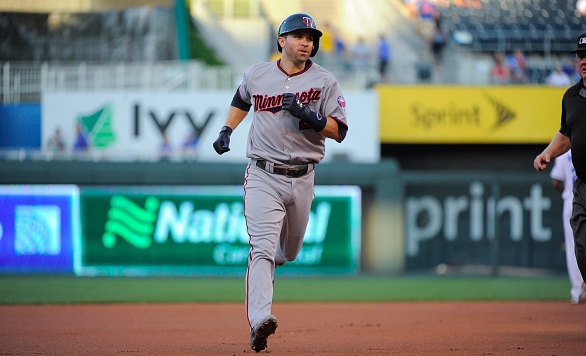After surprising most of baseball by finishing second in the American League Central with a 83-79 record last year, there was reason for the Minnesota Twins to feel optimistic in 2016.
In a year in which a lot of things had to go right for second-year manager Paul Molitor, nothing did. Instead of building off 2015’s success, they own MLB’s worst record at 51-87 entering action on Tuesday.
It’s been especially difficult since August 18. Fresh off a two-game sweep of the equally bad Atlanta Braves, Minnesota has lost 16 of its last 18 games, which included a 13-game losing streak. Playing the Twins has almost guaranteed a victory for the opposing team.
Frankly, second baseman Brian Dozier has been the only reason why Twins fans have smiled consistently over the last couple months. He’s been on an incredible run since the All-Star break, and is on the brink of history because of a prolonged power surge.
Dozier basically supplied all the offense in an 11-5 loss to the Kansas City Royals on Labor Day by collecting three home runs and four RBI. He entered 2016 as a career .240/.340/.411 hitter since debuting in 2012, but is in the midst of a career year. He’s currently hitting .279/.350/.576 with 38 homers, 32 doubles, 91 RBI and 92 runs scored.
What makes this even more impressive is that nobody expected this at the end of May.
Following an All-Star worthy first half in 2015 in which he posted an .841 OPS with 19 homers and 50 RBI in 347 at-bats, his performance fell off a cliff. The second baseman only hit nine more longballs in his final 281 at-bats en route to slashing just .210/.280/.359 in the second half.
Scott Strandberg of RotoGraphs recently detailed this second-half downturn in month-by-month fashion. There was even more reason for concern because the lack of production continued through April and May of this year. Dozier struggled to stay off the interstate during the first couple months with a disheartening .202/.294/.329 line and continually declining power numbers.
What could’ve possibly been the issue here? Well, between his rookie season of 2012 and his All-Star campaign of 2015, he went from being an average pull hitter to an extreme one, according to FanGraphs:
LaVelle Neal of The Star Tribune recently wrote an article where Dozier basically said he was trying to pull the ball too much, thus falling victim to the shift. Once he sat out a couple days to clear his head and refine his approach, that’s when everything changed (quote via The Star Tribune):
“I try to knock down the center field wall. It gets me into the habit of staying behind the ball. I finally realized to take what the game gives you.”
Compared to 2015, his overall pull rate has decreased (56.9 percent) and the rate at which he hits balls to center field has increased (28.2 percent). However, his two best months of the season (June and August) have included a pull rate above 60 percent:
Even though he pulled the ball less often than in April (47.4 percent) and May (53.1 percent), the shift in his mental approach has allowed him to do more damage with the offerings thrown his way.
Dozier’s 34.6 percent hard-hit rate is easily the highest of his career, while he’s showing a little better plate discipline (44.7 percent swing % in ’15, 43.3 percent in ’16) and making more contact overall (79.8 percent in ’15, 80.5 percent in ’16). He’s being more selectively aggressive by going after pitches he can do damage with and not bothering as much with the ones he can’t.
His mental approach may be to knock down the center field wall, but when he gets the pitches he can accomplish that with, they’re still getting pulled. Since Dozier is hitting balls harder more consistently, he’s experiencing more success than ever before. That can also be a reason behind his career-high .281 BABIP at this point in the season.
For a Twins team that’s been borderline unwatchable as a collective unit, Dozier has provided a ray of sunshine on a daily basis since the midsummer classic. Monday’s three-homer barrage now gives him 38 on the season, which is already a new American League record for second basemen (Brett Boone hit 37 in 2001).
Neal noted he could become fourth MLB second baseman to ever hit 40 homers in a season, joining Rogers Hornsby (1922), Davey Johnson (1973) and Ryne Sandberg (1990). Just a few days ago, that was just a possibility, but now it’s a near certainty. This is also a power display Twins fans haven’t seen since the days of Harmon Killebrew, who slugged 41 homers during the 1970 season.
Sometimes, it’s the littlest things that can turn someone’s season around, such as one particular swing that breaks a hitter out of a slump. For Dozier, it was a couple mental health days that led to a shift in mental approach. Such a simple move has enabled him to enjoy one of the biggest displays of power in Twins history, while entering rarified air with regard to power-hitting second basemen.
Nobody would’ve expected that after he struggled to just five homers and 17 RBI through the end of May, but that’s how baseball goes. And during a lost season for Minnesota, it’s good to have something like this to look forward to each night.
Thanks for reading! If you’d like to jumpstart your sportswriting career and aren’t sure how, check out my eBook. Don’t forget to follow me on Twitter so we can chat about baseball: @mmusico8.






















